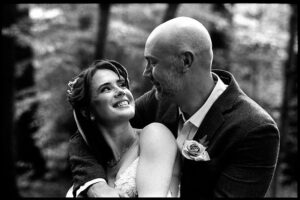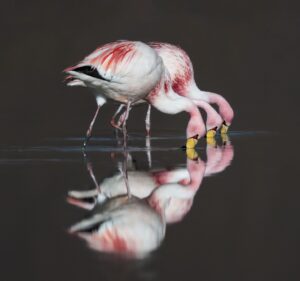
The reality is that I’ve had no one react negatively to that auto responder. It’s been going now six years, plus the additional seventh year of me doing it very contextually on every trip, and there was never a negative response. Usually, if I hear anything back about it, it’s that people say, “Ah, that’s fantastic. I wish I could do that.” And my response to them is always, “But why don’t you?”
Dan Rubin
You can also listen to this episode on iTunes, Pocket Casts, Spotify, Castbox, and Google Podcasts.

Welcome to episode 100! Thank you for supporting Great Big
We have a very special episode for you this week in honour of this achievement. Dan Rubin joins us to have a chat about film
We talk about:
- Why Dan specialises in film
photography - How to utilise technology wisely and have a more creative life
- How to take stunning film photos
& much more!
I had so much fun speaking with Dan and listening to his amazing story. I hope that his perspective on technology inspires you to set boundaries and lead a healthier, happier life.
Here is a preview of our conversation with Dan Rubin.

Q: You said that film photography stops you from constantly checking your photographs and worrying about the next shot. What can photographers do to be more mindful?
Dan Rubin: I think one thing that we can do to be more mindful is just to not look at our cameras, even when we’re shooting digital. I remember talking about this exact topic with a friend of mine, who was also a designer. We were both
Even back then, I was aware that this distraction was a problem because it felt like a problem. It took away from some of the joy and pleasure of just shooting for myself. We put together a few ideas back then, which is kind of funny to look at now because they’re still valid. The world of camera makers hasn’t solved these problems. This comes full circle to one of the things I mentioned earlier about technology not being made to benefit the humans that it’s made for. It’s not something that is just inherent with technology, it’s that it’s just not being thought about or it’s not being prioritised.
We could very easily design digital cameras that were less distracting by default. Maybe you could still look at things if you wanted to, but they shouldn’t be showing us something by default all the time. Because we know as humans that we’re easily distracted, if you give us the chance to be distracted, we’ll be distracted. So one of the things that I started doing very early on – in thinking about this and how to hack my digital camera to make it less distracting – was switching off the auto preview, which anyone can do. Just go into your settings and find the setting that switches the auto preview off. It’ll change the way you shoot without doing anything else to that camera. There are other things you can do, but the biggest thing is to just get out of the habit of shoot, look, shoot, look, shoot, look.

Q: If someone wants to start teaching about photography , what should they do?
Dan Rubin: Sharing is easy. Sharing basically costs you nothing. I always enjoy teaching. I’ve been a teacher in various forms – just sharing what I know and what I’m passionate about with others – since I was very young, whether that was in Boy Scouts as a youth leader or in my music life. I’ve been a choral director and a vocal coach.
In design, the minute that I was able to start teaching people and sharing what I knew, I was excited to do it. I still do that with
I think a lot of the reason why people don’t share and teach is that they assume the opposite: that they’re the last person to to find out this trick, or that this trick isn’t actually much of a trick, it’s just a bit of a hack. One of the things I learned very, very early on about teaching in general is that you have to assume that no one in the audience knows what you’re about to tell them. This is especially true when you’re getting up on a stage in front of thousands of people to teach them how to speak at a conference or to put yourself out there on the Internet, which might be to thousands, or hundreds of thousands, or millions of people.

What if we’re laughed at? What if we say this thing and everyone goes, “You think that’s special? We already all knew that!” It’s a very natural human emotion to be intimidated by that prospect. We just need to get over it. If we look at everyone who teaches and shares, it’s not that everything that they’re teaching is brand new information. We could very easily watch a conference presentation, a Skillshare course, or a YouTube video and learn maybe one thing. Maybe we don’t learn anything from that video because we already happen to know that. But even when we do learn, it’s rare that we’re learning everything from scratch because we’re already involved in whatever that profession or hobby or interest is. The only way that we’re likely to learn something completely new, that we have no knowledge of, is when we’re learning about some topic that we have no knowledge of, which is totally fine as well.
But as people who are teaching and sharing, we just have to realise that as humans, we come up with all sorts of interesting combinations of steps, tricks, processes, and workflows. In sharing the way we do something, we might open a doorway for someone who hadn’t thought of doing it that way before because their brain operates differently from ours. That’s where the value is.

Q: I read somewhere that you have over 50 cameras?!
Dan Rubin: I wasn’t going to mention it because I’m not trying to brag. I think it’s way more than anyone needs. I haven’t actually done a full count in a few years. The last time I did, it was just over 50. That is a lot of cameras, but as a product designer, it’s not a lot of examples. Or it’s actually a good amount of examples of a span of different styles.
At least 10 of those 50 are versions of the Polaroid SX70, the folding Polaroid that started started its life in the early 1970s. That camera was what actually got me into
Very early on, I would find all the different models of them, some of them broken, some of them working. I would just snap them up in case I needed spare parts, or maybe I would find other versions. They were all cheap because no one wanted them back then since the film had been discontinued. There’s a very long, ungainly version that has autofocus and a flash. The SLR 680. I have one of those. It’s very easy to get to 10 out of that 50 that are just Polaroids. Aside from that, it’s still more cameras than anyone needs.
Check out Dan Rubin’s Work
Join Our Photography Community!









